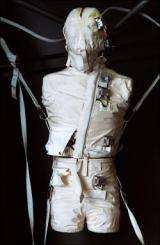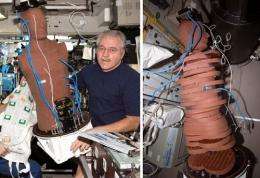The Phantom Torso.
The Phantom Torso is back, and he has quite a story to tell. He's an armless, legless, human-shaped torso, a mannequin that looks like he's wrapped in a mummy's bandages. Scientists at the European Space Agency call him Matroshka, and like his NASA counterpart Fred, this mannequin is an intrepid space traveler. Now that he's spent four months on the International Space Station, scientists are learning about the space radiation that Matroshka endured.
Lessons learned from Fred and Matroshka have major implications for NASA's plans to set up a manned outpost on the Moon and eventually to send people to Mars. Protecting astronauts from the harmful effects of space radiation will be a critical challenge for these extended missions. To design spacesuits, vehicles, and habitats with enough shielding to keep astronauts safe, mission scientists need to know how much radiation --and what kinds --astronauts actually absorb.
Scientists can estimate this radiation dose using computer models, but a computer model and real-life can be two wildly different things. Until now, researchers weren't sure whether their models accurately predicted the radiation dose astronauts experience in space.
That's where the Phantom Torso comes in.
He provided the real-world test needed to prove that the models are essentially correct. By analyzing the measurements from hundreds of radiation sensors embedded throughout Matroshka's body, Francis Cucinotta of NASA's Johnson Space Center and his colleagues found that the models are actually quite good: They're accurate to within 10% of the measured dose. That means it's "all systems go" for using these models to plan NASA's return to the Moon or even a trip to Mars.
(Left) ISS Science Officer John L. Phillips poses for a picture beside Matroshka, the ESA's Phantom Torso. (Right) Radiation sensors are embedded in 35 different slices of the Phantom Torso.
The most dangerous kind of radiation astronauts experience is galactic cosmic rays (GCR). These are bare atomic nuclei, some as heavy as iron atoms, accelerated to nearly the speed of light by distant supernovas. Because of their high velocity, high mass, and positive electric charge, GCR particles can cause tremendous damage to a person's cells. And traditional radiation shielding can't stop them.
Understanding the danger isn't as simple as just knowing how much radiation is out there.
"What matters most is how much radiation actually hits a person's vital organs," says Cucinotta.
And to reach those organs, particles of radiation must first pass through the walls of the spacecraft, the person's spacesuit, and their skin and other body tissues. It's very complex. Sometimes these barriers will slow down or stop a particle of radiation. But sometimes the collision between a radiation particle and a barrier will produce a shower of new radiation particles called "secondary" radiation. Computer models must account for all of this.
Space station astronauts wear sensors on their flight suits to record total radiation exposure, but there's no practical way to measure how much radiation actually reaches their vital organs. Fred has sensors just about everywhere--even on the inside.
The Phantom Torsos are made of a special plastic that closely mimics the density of the human body, sliced horizontally into 35 one inch layers. In these layers, researchers embedded a total of 416 lithium-crystal dosimeters, each of which measures the accumulated radiation dose at one point in the body over the course of the experiment. Fred and Matroshka also contain several "active" dosimeters located where vital organs such as their brain, thyroid, heart, colon, and stomach would be. These active sensors keep a record of how the radiation dose changes moment by moment. Together, these various sensors thoroughly documented how radiation propagate through their bodies.
"The geometry and the composition of the torso mimics the human body very well," Cucinotta says. "I think it's a very good test."
So now that these computer models have been verified in the real world, what do they say about keeping astronauts safe in a lunar outpost or on Mars?
"Short lunar missions are fine," Cucinotta says, "but living in a lunar habitat for 6 months starts to be problematic. We're going to have to do a really good job with radiation shielding and perhaps medical countermeasures to have 6-month missions."
Mars will be even tougher, these models suggest. Some scenarios call for missions that would last 18 months or more. "Right now there's no design solution to stay within safety limits for such a Mars mission," Cucinotta says. "Putting enough radiation shielding around a spacecraft would make it far too heavy to launch, so we need to find better lightweight shielding materials, and we probably need to develop medical techniques to counteract damage to cells caused by cosmic rays." He notes that one of the biggest obstacles to progress in this area is "uncertainty in the types of cell damage deep cosmic ray exposure can cause. We still have a lot to learn."
Another key question: How do solar flares affect astronauts? Fred and Matroshka have not experienced any intense solar radiation storms during their time onboard the ISS.
"The energy spectrum of solar events and how the radiation dose changes from organ to organ will be very different than what we have seen so far from cosmic rays," says Cucinotta.
To find the answer, scientists have recreated the intense radiation from giant solar flares right here on Earth, and Matroshka has been chosen as the unlucky volunteer who will experience the blast. A fake astronaut is about to be subjected to an artificial solar flare!
Stay tuned to Science@NASA for the second half of this two-part article, which will explore these pioneering new experiments as well as a historical example of an extreme solar flare that, in 1972, narrowly missed Apollo missions to the Moon.
References:
"Astronaut's Organ Doses Inferred from Measurements in a Human Phantom Outside the International Space Station" by Guenther Reitz et al.: Radiation Research, 171, 225-235 (2009)
"Physical and Biological Organ Dosimetry Analysis for International Space Station Astronauts" by Francis A. Cucinotta, Myung-Hee Y. Kim, Veronica Willingham and Kerry A. George: Radiation Research 170, 127-138 (2008)
Source: Science@NASA, Dr. Tony Phillips



















